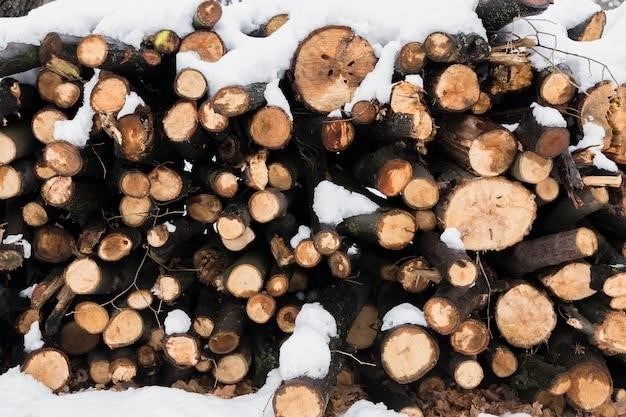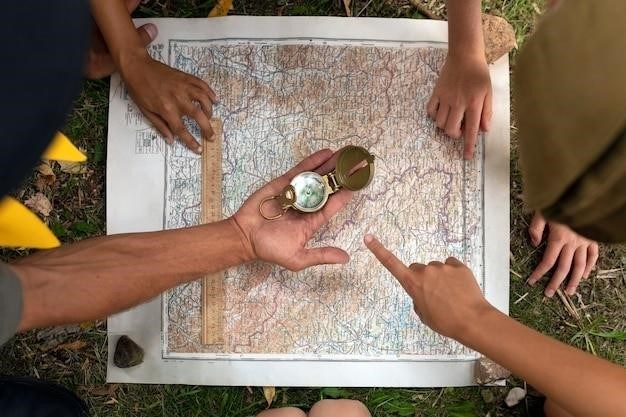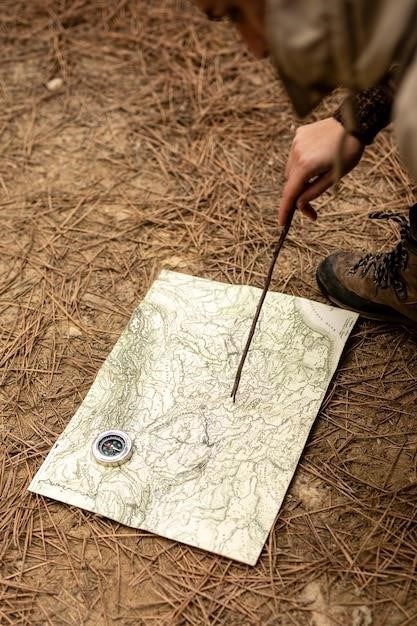Firewood Collection in Washington State⁚ A 2024 Guide
Washington State offers various resources for firewood collection. Obtain necessary permits and maps online or from local DNR offices. Check for updated 2024 PDF maps detailing permitted areas and regulations to ensure legal and safe firewood harvesting. Remember permit validity periods and restrictions.
Obtaining Firewood Permits in WA
Securing a firewood permit in Washington State for the 2024 season involves several steps. First, determine your need⁚ personal use or commercial. Personal use permits, often free for a limited quantity, are available for residents to gather firewood for their own use. Commercial permits are required for those intending to sell firewood, and fees vary depending on the volume harvested. The Washington Department of Natural Resources (DNR) and local Department of Biodiversity, Conservation, and Attractions (DBCA) offices are primary sources for permit applications. You can often access and download permits online, though in-person applications might be necessary depending on your location and the type of permit needed. The application process typically involves providing personal information and specifying the intended harvesting area. Remember that permits may have restrictions on the quantity of firewood allowed and the designated areas where harvesting is permitted. Always check for specific requirements and any associated fees before applying. Failure to obtain a permit can lead to significant fines, so ensure you are fully compliant before starting your firewood collection. After receiving the permit, carefully review all terms and conditions to avoid any penalties.
Permit Types and Costs⁚ Personal vs. Commercial
Washington State offers distinct firewood permit types catering to personal and commercial needs. Personal-use permits, designed for residents gathering firewood for their own consumption, are often free or come with minimal fees. These typically allow for a limited quantity of firewood, sufficient for household use, and might be subject to location restrictions. Conversely, commercial permits are necessary for individuals or businesses intending to harvest and sell firewood. These permits involve a more substantial cost, usually calculated per cord of wood harvested. The pricing structure for commercial permits reflects the larger scale of operation and the potential for greater environmental impact. The permit application process for commercial use might be more rigorous, involving additional documentation and possibly inspections. Obtaining the correct permit is crucial; using a personal-use permit for commercial activities can result in hefty penalties. Always clarify your intended use when applying to ensure you select the appropriate permit type and avoid potential legal issues. Contact your local DNR or DBCA office for detailed information on current pricing and application procedures for both personal and commercial firewood permits in your specific area.
Where to Collect Firewood⁚ Designated Areas and Restrictions
Firewood collection in Washington State is not permitted everywhere. Designated areas, often managed by the Department of Natural Resources (DNR) or other land management agencies, are specifically opened for firewood harvesting. These areas are clearly marked on official maps, often available as downloadable PDFs from the DNR website or local offices. These maps provide crucial information, delineating permitted zones and highlighting areas where collection is prohibited. Restrictions are in place to protect sensitive ecosystems, prevent the spread of invasive species like Phytophthora dieback, and ensure sustainable forestry practices. Collecting firewood outside designated areas is illegal and subject to significant fines. Remember that even within designated areas, restrictions may apply; for example, limitations on the amount of firewood you can harvest or specific areas within the designated zone off-limits for collection. Always consult the official maps and accompanying guidelines before heading out to collect firewood. Ignoring these regulations can lead to legal repercussions and harm the environment. Properly utilizing the available maps and adhering to all stated restrictions ensures responsible and legal firewood collection.
Regulations and Guidelines for Firewood Harvesting
Harvesting firewood in Washington State requires adherence to specific regulations and guidelines to ensure responsible resource management and environmental protection; These regulations often involve obtaining the necessary permits before collecting any firewood, with permit types varying depending on the intended use (personal or commercial). The amount of firewood you can collect is usually limited to prevent overharvesting. Specific guidelines might restrict the types of trees you can harvest, focusing on dead or downed trees to minimize harm to the living forest. To prevent the spread of invasive pests and diseases, such as Phytophthora dieback, regulations often dictate that you only collect firewood from designated areas and avoid collecting wood during wet conditions. Additionally, regulations often specify that you must stay on existing roads and trails to minimize environmental impact. Transportation of harvested firewood may also have specific guidelines, potentially requiring the use of designated routes or methods to prevent the spread of invasive species. Failure to comply with these regulations can result in fines and penalties. Always check the most up-to-date regulations and guidelines from the relevant authorities before you begin your firewood harvesting activities to ensure compliance and responsible resource management. Remember that responsible harvesting protects the environment and ensures the sustainable availability of firewood for future generations.
Preventing the Spread of Phytophthora Dieback
Phytophthora dieback is a devastating disease affecting many tree species, and preventing its spread is crucial for maintaining the health of Washington’s forests. When collecting firewood, avoid areas known to be infected with Phytophthora. This information is often available through local forestry agencies or online resources, potentially included in the firewood collection maps. Never move firewood from an infected area to an uninfected one. The spores of Phytophthora can easily spread through contaminated soil and water, adhering to equipment, vehicles, and even clothing. Thoroughly clean any equipment used for firewood collection before and after each use, paying particular attention to removing any soil or debris. Avoid collecting firewood during wet conditions as the spores are more easily dispersed in damp environments. If you suspect that you have collected firewood from an infected area, immediately contact your local forestry agency for guidance. They can provide advice on proper disposal methods to prevent further spread of the disease. Following these guidelines contributes significantly to the protection of Washington’s forests and the preservation of its biodiversity for years to come. Responsible firewood collection practices help to maintain the ecological balance.
Legal Requirements for Firewood Sales in WA
Selling firewood in Washington State requires adherence to specific legal regulations. A permit from the Department of Natural Resources (DNR) is mandatory for commercial firewood sales. This permit ensures compliance with state laws and protects both sellers and buyers. Accurate record-keeping is essential; maintain detailed records of all transactions. When providing a receipt to your customer, include crucial information such as the seller’s and buyer’s details, purchase date, price, quantity of firewood sold, and the type of wood. This detailed record-keeping aids in traceability and accountability. The legal measurement for firewood in Washington is the cord; ensure accurate measurement and pricing based on this standard unit. Failure to comply with these regulations can result in penalties, including fines and potential legal action. Familiarize yourself with the current DNR guidelines and regulations before commencing any firewood sales. Regularly check for updates or changes in legislation to maintain compliance. The DNR website is a valuable resource for obtaining the most up-to-date information regarding permits, regulations, and best practices for legal and responsible firewood sales in Washington State. By adhering to these legal requirements, you contribute to a fair and transparent marketplace for firewood, protecting both businesses and consumers.
Firewood Collection Maps and Resources

Accessing detailed maps is crucial for legal and safe firewood collection in Washington. The Washington Department of Natural Resources (DNR) provides invaluable resources, including downloadable PDF maps, pinpointing designated firewood collection areas (DFCAs) across the state. These maps clearly delineate permitted areas, highlighting boundaries and restrictions. Before venturing out, always download the most recent versions of these maps. Ensure you’re collecting within designated zones to avoid penalties. In addition to DNR maps, some national forests and other land management agencies might offer their own specific maps for firewood harvesting. Check their websites or contact their offices for details. Supplement your map research with online resources. Websites and online forums dedicated to outdoor recreation in Washington often share user-submitted information, including tips on prime firewood locations and potential hazards. Always cross-reference this information with official DNR maps to confirm legality. Remember to bring a printed copy of your permit and the relevant map to your collecting site. This ensures compliance and facilitates quick verification by authorities if necessary. By utilizing these resources effectively, you’ll be well-prepared for a safe and productive firewood gathering experience within Washington’s diverse landscapes.
Accessing and Downloading Firewood Permits Online
The convenience of online permit acquisition simplifies the firewood collection process in Washington. The Washington Department of Natural Resources (DNR) website typically offers a user-friendly portal for permit applications. Navigate to the dedicated section for firewood permits, usually found under a heading like “Forest Resources” or “Recreation Permits.” You’ll likely encounter a clear application form requiring personal details, including contact information and desired permit type. After completing the form, you might need to pay a fee, depending on the permit type (personal use versus commercial). Secure online payment options are usually available. Once the application and payment are processed, you’ll receive confirmation through email. This confirmation may include a link to download your permit immediately, often in a PDF format. Always download and print a copy for immediate access. Some systems might require you to wait a short processing period before the permit becomes accessible. Check your email for updates if the download isn’t immediate. Save the permit and keep it readily available during your collection trips. Always ensure the permit contains all necessary information and is valid for the relevant dates and areas. Contact the DNR directly if you encounter any issues accessing or downloading your permit online.
Permit Validity Periods and Usage Restrictions
Firewood permits in Washington State possess specific validity periods and usage restrictions. Understanding these limitations is crucial to avoid penalties. Permit validity typically spans a defined timeframe, often aligned with the firewood season (e.g., April 15th to December 1st, or similar). The exact duration is specified on the permit itself and should be carefully noted. Exceeding the validity period renders the permit invalid, leading to potential fines. Furthermore, geographic restrictions may apply. Permits usually authorize firewood collection only within designated areas, often detailed on accompanying maps (PDF or otherwise). Collecting firewood outside these specified zones constitutes a violation, regardless of permit possession. Quantity limits frequently accompany personal-use permits; exceeding these limits also results in non-compliance. Commercial permits, in contrast, may have different or higher quantity allowances, but still necessitate adherence to specific regulations. Additionally, certain areas might have additional rules regarding cutting methods, tree species allowed for harvesting, or minimum distances from roads and trails; Always consult the permit and any supplementary documentation for comprehensive understanding of the applicable limitations. Ignoring restrictions can result in significant consequences, including fines and permit revocation.
Fines and Penalties for Unauthorized Firewood Harvesting
Unauthorized firewood harvesting in Washington State carries significant consequences. Fines for operating without the required permit range considerably, from a relatively minor penalty of $50 to a substantially larger sum of $2,000 or more, depending on the severity and nature of the violation. The penalties are not limited to monetary fines; individuals found to be in violation may also face the suspension of their firewood permit privileges for a specified period, often one year. This means that, even if the monetary fine is paid, the individual will be barred from obtaining a permit for a considerable amount of time. The loss of permit privileges effectively prevents further legal firewood collection during the suspension period. Furthermore, the legal repercussions extend beyond individual penalties. Depending on the scale of the unauthorized harvesting, more extensive legal actions might be pursued. This could involve court appearances and potential further fines or even more stringent penalties. The specific penalties imposed vary according to the infraction, the amount of firewood harvested illegally, and the individual’s history of compliance. Therefore, it is essential to obtain the necessary permits before engaging in any firewood collection activities to avoid incurring these substantial fines and penalties. Always refer to the relevant Washington State regulations and guidelines for detailed information on permitted areas, harvesting limits and other specific rules to ensure full compliance.

Contacting Relevant Authorities for Permit Information
Securing the necessary permits for firewood collection in Washington State requires contacting the appropriate authorities. The Washington Department of Natural Resources (DNR) is a primary point of contact for information regarding permits and regulations concerning firewood harvesting on state trust lands. Their website often provides downloadable permit applications and detailed information about permitted areas. However, for specific questions or clarifications, contacting them directly via phone or email is recommended. Additionally, depending on the location of intended firewood collection, contacting local Department of Biodiversity, Conservation, and Attractions (DBCA) offices might be necessary. These offices often manage permits for areas under their jurisdiction. For federally managed lands, such as those within National Forests, contacting the relevant United States Forest Service (USFS) office is crucial. Each office has specific procedures and requirements for permit applications. Remember to specify the area where you intend to collect firewood when contacting any of these authorities. This information helps them direct your inquiry to the correct personnel who can provide accurate and timely assistance. Finally, always verify the contact information on official websites to ensure you are reaching the most up-to-date contact details for the relevant agency.
